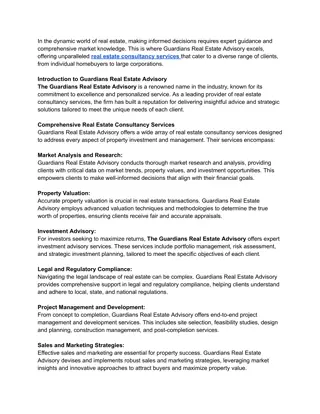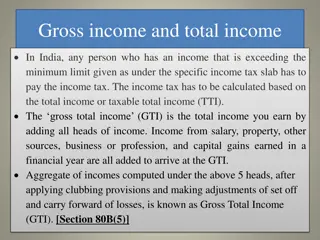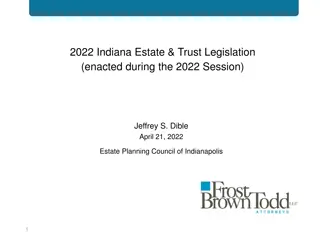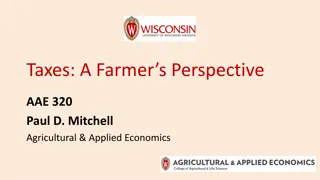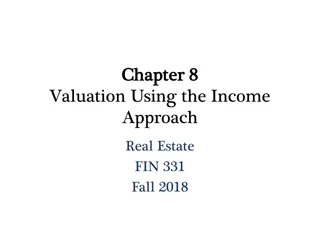Understanding Trust Income Allocation in Estate Planning
Dive into the complexities of trust income allocation, distinguishing between principal and income in trusts and exploring examples of how various types of income are treated for trust accounting purposes. Learn about the rules governing income distributions and the implications for beneficiaries.
Download Presentation

Please find below an Image/Link to download the presentation.
The content on the website is provided AS IS for your information and personal use only. It may not be sold, licensed, or shared on other websites without obtaining consent from the author. Download presentation by click this link. If you encounter any issues during the download, it is possible that the publisher has removed the file from their server.
E N D
Presentation Transcript
When Income isnt Income. Or is it? Spokane Estate Planning Council September 18, 2018 David Green CPA 509-850-3740 david@davidgreencpa.com
Discussion areas Trust Accounting Income Types of Trusts Taxation of Trusts Problem Areas Avoiding Oopsies 2017 Tax Legislation
Trust language The Trustee shall pay the entire net income of the trust to the beneficiary, in quarterly or more frequent installments, for the duration of the trust. What does this mean?
Principal and income laws RCW 11.104A Washington Principal and Income Act of 2002 Contains the rules governing what is income vs. what is principal in connection with the taxation of fiduciaries and their beneficiaries. Income Amounts which are typically allocable to the income beneficiary of the trust. Principal Amounts which are typically allocable to the holder of the remainder interest in the trust --- e.g., the person who receives the trust assets after the income beneficiary s interest has terminated. Important for trust accounting income purposes The calculation of who is entitled to what based on the receipts and expenditures of the trust.
Income income Typically includes receipts such as: Interest income. Dividend income. Cash distributions from entities such as LLCs, partnerships, S corporations, REITs, etc. Potential mismatch between the taxable income of the entity (e.g., the amounts appearing on the Schedule K-1) versus the income of the entity (e.g., the cash flow from the entity). Rent income from a rental property.
Example 1 First year Schedule K-1 from an LLC shows a $10k loss, and $15k in cash is distributed from the LLC to the trust during the year. What is the income for trust accounting purposes? $15,000, allocated to income. If this is the only asset owned by the trust (and the trust has no expenses allocable to income), how much in distributions from the trust should the beneficiary receive? $15,000.
Example 2 First year Schedule K-1 from an LLC shows $100k in interest income, and $50k in cash is distributed from the LLC to the trust during the year. What is the income for trust accounting purposes? $50,000, allocated to income. If this is the only asset owned by the trust (and the trust has no expenses allocable to income), how much in distributions from the trust should the beneficiary receive? $50,000.
Example 3 First year Schedule K-1 from an LLC shows $100k in interest income, and $-0- in cash is distributed from the LLC to the trust during the year. What is the income for trust accounting purposes? $-0- (no cash was received). If this is the only asset owned by the trust (and the trust has no expenses allocable to income), how much in distributions from the trust should the beneficiary receive? $-0-.
Principal income Typically includes receipts such as: Additions to the trust from the grantor/settlor. Realized profit from the sale or exchange of trust assets. Proceeds of a life insurance policy.
Example 4 Trustee sells $100,000 of stock and recognizes $20,000 in long-term capital gains in 2018. What is the income for trust accounting purposes? $20,000, allocated to principal. If this is the only asset owned by the trust (and the trust has no expenses allocable to income), how much in distributions from the trust should the beneficiary receive? Nothing --- the $20,000 in capital gains is allocated to principal. The beneficiary is only entitled to income .
Expenses of a trust Expenses of a trust have to be allocated between income and principal , similar to receipts. Rules contained in RCW 11.104A.250: Trustee fees: 50/50 allocation Other expenses that involve both the income and remainder interests (tax return preparation fees, investment advisory fees, etc.): 50/50 allocation Interest expense, ordinary repairs, real estate taxes, hazard insurance premiums, etc: 100% to income Income taxes on principal: 100% to principal
Typical Trust Accounting Income (TAI) Calculation Income Principal Interest Income Dividend Income Capital Gains Trustee Fees Tax Return Preparation 5,000 10,000 25,000 -5,000 -1,000 -5,000 -1,000 Net Amount 9,000 19,000
Types of trusts Simple Trust All income is required to be distributed. Complex Trust Anything other than a simple trust. Other Variations Grantor Trust The person who set up the trust is taxed on the activity of the trust (sometimes known as a defective trust ). Life Insurance Trust - If trust income may be applied to pay premiums on the grantor s life, grantor trust rules will apply.
Taxation of trusts Form 1041 is used to report the income and deductions of trusts. It also serves as a mechanism for determining who pays the tax on income in the trust --- the trust or the beneficiaries? DNI Distributable Net Income . A calculation for tax return reporting purposes (page 2, Form 1041, Schedule B) that determines how much the beneficiary will be taxed on the beneficiary s share of the trust s income. A corresponding deduction will be available to the trust for the share of the income that the beneficiary receives. 2017 tax legislation may cause TAI to be less than DNI (back door tax increase on simple trusts).
Simple trust A simple trust is one in which all income is required to be distributed . Beneficiary pays tax on income . Doesn t matter whether the income is actually distributed to the beneficiary by the trustee. Trust pays tax on principal .
Simple trust example Income Principal Interest Income Dividend Income Capital Gains Trustee Fees Tax Return Preparation 5,000 10,000 25,000 -5,000 -1,000 -5,000 -1,000 Net Amount of TAI 9,000 19,000
Complex trust A complex trust is a trust other than a simple trust . Beneficiary pays tax on income only if it is distributed to the beneficiary. 65 day rule can apply. Election under IRC section 663(b) to treat distributions actually made during the first 65 days of the next tax year as having been made on December 31 instead. Trust pays tax on principal .
Complex trust example Income Principal Interest Income Dividend Income Capital Gains Trustee Fees Tax Return Preparation 5,000 10,000 25,000 -5,000 -1,000 -5,000 -1,000 Net Amount of TAI 9,000 19,000
Problem areas - investing Bonds purchased at a premium. Amortization of bond premium isn t allocable to the income beneficiary under the Principal & Income Act (RCW 11.104A.150(a). Potential power to adjust under RCW 11.104A.020(a), but specific requirements exist to do this. Preference would be to have power to adjust written into the trust instrument. Example: $100k face value 5% bond purchased at a premium. $5,000 interest paid annually. Amortization of bond premium is $3,999.
Problem areas - investing Market discount bonds (RCW 11.104A.150(b)). Maturity greater than a year when acquired, market discount income is allocable to principal. Maturity less than a year when acquired, market discount income is allocable to income.
Problem areas - drafting Considerations to thing about: Fiduciary s ability to allocate between principal and income for common fact patterns (fixed income investments purchased at a premium or discount). Should the trust be a total return trust? But watch marital trust requirement to give surviving spouse all of the trust income annually.
Avoiding oopsies Always have a copy of the trust instrument in the file. For complex trusts, be aware of the election under IRC section 663(b) to treat distributions made in the first 65 days of the next year as having been made in the current tax year. If large amount of capital gains have been realized by the trust, language in IRC 643(a)(3) can cause capital gains to be taxed to the beneficiary if (1) actually paid to the beneficiary during the year, and (2) if doing so is permitted by the trust instrument.
Avoiding oopsies The calculation of trust accounting income is important, but rarely reviewed by anyone other than the accountant. It s worth a second look by the trustee. Watch for potential mismatches in flow-through taxable income and flow-through cash distributions. Align current year taxable income with current year cash distributions if there is a reasonably large fluctuation in taxable income from year to year.
2017 Tax Cuts and Jobs Act Lower rates on ordinary income (10%, 24%, 35%, 37%). State and local taxes capped at $10,000 per year. Exception for trade or business or Section 212 activity. Miscellaneous itemized deductions suspended. No deduction for investment fees (separately billed). Clarification required for trustee fees. Personal exemptions continue for trusts and estates. No change to AMT law for trusts and estates. Watch for DNI/TAI interaction. (TAI hasn t changed, but DNI will increase as tax deductions are lost). And the income distribution deduction (IDD) for simple trusts is the lesser of TAI or DNI per IRC 651(b).
Potential tax increases for simple trusts due to 2017 tax legislation Example from Income taxation of trusts and estates after tax reform (thetaxadviser.com) May 1, 2018. TAI isn t impacted by the 2017 legislation, but adjusted total income (and DNI) is. $13k in real estate taxes (allocable to income for TAI). IDD = lesser of TAI or DNI. Simple trust example.






